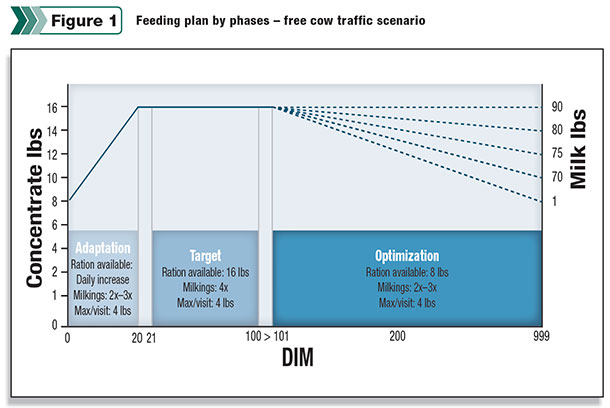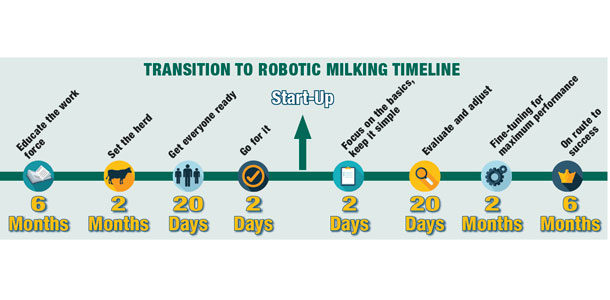Editor’s note: This article is the second in a series. Click here to read the first article. Once the robots are fired up and the real journey has begun, it is time to focus on the right areas by planning for a bright future. Keep in mind that with a good plan in place nothing but good things will happen, and from now the sky is the limit.
Two days post-startup: Focus on the basics and keep it simple
The beginning is the most difficult part of any change. By now both you and the cows are in the steadiest part of the learning curve. You have acquired a very capable piece of technology and, as expected, you may feel very attracted by it. However, it is crucial to prioritize your efforts in order to have the smoothest transition by focusing on the fundamentals.
It is important to ensure the entire system is configured at a baseline where each area can function without major adjustments or in what is called a “safe mode.” Beginning in safe mode enables you to focus on daily routines and, most importantly, herd adaptation. In other words, you organized a big party, you invited the girls, and now you must be the best hostess:
1. Milking intervals and milk frequency: The goal by the end of the first week is greater than 2.5 milkings per cow per day with a minimum of two milkings per cow per day for all animals. In order to ensure milking intervals under 12 hours and an appropriate balance between milk frequency and robot usage, it is important to set adequate milking permissions based on stage of lactation:
- One to 100 days in milk (DIM): four hours or 14 pounds expected yield
- 100 DIM until 40 days before dry-off: six hours or 16 pounds expected yield
- Less than 40 days before dry-off: eight hours or 18 pounds expected yield
Remember, with guided cow traffic it is essential to ensure proper smart selection gate configurations and holding area management by setting cow counters and maximum capacity based on area per cow and robots per holding pen. Ideally, cows should have 45 square feet per cow in the holding area and no more than seven cows allowed per robot.
The goal is to harvest 30 pounds per milking, and although these milking permissions parameters seem to be much lower than listed, remember that cows will not have access to the robot at every single attempt, as it might be in use or a group of cows are already queuing, etc. Therefore, adding flexibility in the beginning is important.
2. Fetching: Due to the learning process, and based on your milking queue reports, it is important to guide overdue cows (more than 12 hours since last milking) to the robot. A gradual process must be implemented based on how fast the herd is adapting to new cow flow.
Start fetching overdue cows every four hours, then as cows learn and number of overdue animals start decreasing, the fetching intervals can be extended to every six hours, then eight hours, up to the point where fetching occurs every 12 hours or just twice a day.
3. Milking procedure: Make sure the entire tool kit is being used in order to protect udder health at all times:
- Use compatible/sprayable teat dips.
- Maximize teat coverage through appropriate nozzle size, spray pattern, proper indexing of cows and arm speed.
- Pre-milking and post-milking spraying of teats with an effective disinfectant is highly recommended.
- Use of an approved disinfectant diluted accordingly for teat cleaning is necessary.
- Set the system for heavy teat cleaning level regardless of bedding system or surface cleanliness. This way your cows will be at maximum level of protection.
4. Feeding: The main objective is to motivate cows in order to maximize visit frequency to the robot at all stages of lactation so consistent cow flow patterns are developed and fetch rates are minimized.
Cows must always have feed available at the feedbunk, meaning feed cows at least twice per day ensuring frequent push-ups, at least every four hours. Concerning feed at the robot, an adequate baseline for feeding parameters is necessary:
- Feed available per cow per day: Depending on the kind of cow traffic scenario, levels of grain must vary. In order to keep it simple so you can focus on the fundamentals, a basic but safe feeding strategy must be in place. Set a fixed amount of feed available per day and per visit for all cows so the entire herd is equally motivated. This is a recommended strategy for the first 20 days post-startup only.
- Free-flow or feed-first pre-selection: 16 pounds per cow per day available for all cows, 4 pounds per visit
- Milk-first pre-selection: 8 pounds per cow per day available for all cows, 2 pounds per visit
As expected, feed consumption will vary according to milk frequency; therefore, partial mixed rations (PMR) should be balanced during this period according to the average feed consumed per day reported by the system.
5. Bedding management: As this is a stressful period for the cows and the udder is adapting to the new system, clean stalls and a dry, comfortable bedding surface must be provided at all times. Clean alleys are necessary as well.
6. Data management: At this point, you should be able to manage action and key performance reports with a very simple approach, focusing on daily tasks and making sure the herd is moving in the right direction. Screening of essential reports three times a day is enough. Avoid fine-tuning and frequent adjustments during this period.

20 days post-startup: Time to evaluate and adjust
Once the most stressful period has occurred and both cows and people are adjusting to their new lifestyle, it is time to evaluate and start adjusting the system:
1. Feeding: Based on cow traffic, feeding strategies, feeding quantities, days in milk, milk frequency and milk production, implementing a customized feeding plan for the operation is highly recommended, considering the three feeding phases of feeding in robotics:
- Adaptation: zero DIM until 15 to 21 DIM
- Target: 15 to 21 DIM until 70 to 100 DIM
- Optimization: greater than 70 to 100 DIM
Once the feeding plan is designed and reviewed by the management team, including advisers, then the next step is to configure the system. Make sure you have appropriate understanding of the different settings and parameters; otherwise, consult you equipment provider.
Last but not least, ensure that individual feed consumption at the robot is higher than 80 to 90 percent on 72 hours average; if some animals are less, then troubleshooting is necessary.
2. Fetching: Now that the majority of the cows are visiting the robot on their own, it is time to evaluate fetch rates and fetching times, and therefore, adjust routines if necessary. The key aspect at this time is to start prioritizing fetching based on stage of lactation. Milking intervals in fresh cows shouldn’t be higher than eight hours, while mid-lactation and late-lactation cows can continue with 12 hours.
3. Evaluate milking performance: Identify animals presenting difficulties while attaching or milking, as there are several factors that can interfere with appropriate performance, especially the ones related to udder conformation, teat shape, animal temperament or even udder cleanliness.
It is recommended to evaluate the performance index per cow. Ideally, you would like to have the entire herd above 100, which means an attachment time of less than 15 seconds per teat or one minute total. Focus on the animals that are below that threshold, prioritizing the ones in the lowest part of the range.
4. Milk quality and udder health: Daily screening of udder health indicators is crucial; ensure proper report design and management routines. Regardless of the technology, udder health must be a priority, especially as your physical contact with the herd is probably less than before. Animals with abnormal indicators must receive a physical exam so actions such as culturing can be made on time.
5. Data management: Now is the time to get more involved in system configuration and details, especially in two key areas: milking procedure and feeding management. Assessing and measuring become a very important part of your daily routines.
Two months post-startup: Fine-tuning for maximum performance
Now that the herd has settled, people have learned, and the entire system is hungry for improved performance, it is time to start exploring new opportunities:
- Feeding: Fine-tune dispensing rates at group level and dispensing speed at cow level. This will ensure that cows receive what they deserve while enjoying their milking; this has a positive impact on letdown and therefore milking speed.
- Stall times and robot performance:
- It is recommended to stop dispensing feed when only two quarters are being milked, as this will ensure that by the time the milk flow ends, the cow has no feed left in the feed bowl; therefore, leaving the station for the next cow is the only option.
- Evaluate yield per milking individually and adjust milking permissions at group level or cow level if necessary; this will optimize robot usage.
- Evaluate udder health and teat cleaning parameters so teat cleaning level can be adjusted. Getting clean cows to the robot pays; less cleaning times equals more available milking times.
- Breeding: Ensure proper configuration of activity systems and breeding reports; now is the time to leverage other sides of the technology in order to improve crucial areas such as reproduction.
Six months post-startup: Setting your goals en route to success
It is time for strategic planning based on scenarios and time tables. Setting short-term, mid-term and long-term goals and actions will drive your herd to the stage you have always desired; keep up with the great work and good luck! PD
Francisco Rodriguez is a veterinarian and works for DeLaval as an adviser for automated milking systems in North America.

Francisco Rodriguez
Dairy Management Adviser – Automatic Milking Systems
DeLaval Inc.






